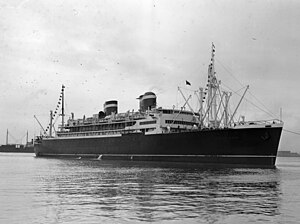
USS Susan B. Anthony (AP-72) was a turbo-electric ocean liner, Santa Clara, of the Grace Steamship Company that was built in 1930. Santa Clara was turned over to the War Shipping Administration (WSA) on 28 February 1942 and operated by Grace Lines as agent for WSA as a troop ship making voyages to the South Pacific. The ship was chartered to the Navy on 7 August 1942 for operation as a United States Navy transport ship. The ship was sunk 7 June 1944 off Normandy by a mine while cruising through a swept channel with all 2,689 people aboard being saved.

USS New Hanover (AKA-73) was a Tolland-class attack cargo ship in service with the United States Navy from 1944 to 1946. She was sold into commercial service and was scrapped in 1970.
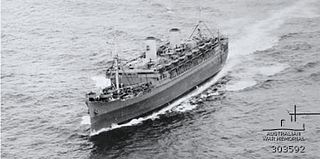
SS Mariposa was a luxury ocean liner launched in 1931, one of four ships in the Matson Lines "White Fleet", which included SS Monterey, SS Malolo, and SS Lurline. She was later renamed SS Homeric.

SS Manhattan was a 24,189 GRT luxury ocean liner built for the United States Lines, named after the Manhattan borough of New York City. On 15 June 1941 she was commissioned as USS Wakefield (AP-21) and became the largest ship ever operated by the US Coast Guard. In 1942 she caught fire and was rebuilt as a troop ship. Post-war, she was moored in New York in May, before decommissioning in June 1946. She was laid up in reserve at Jones Point, New York. She never saw commercial service again, and was sold for scrap in 1965.

SS Argentina was a US turbo-electric ocean liner. She was completed in 1929 as SS Pennsylvania, and refitted and renamed as SS Argentina in 1938. From 1942 to 1946 she was the War Shipping Administration operated troopship Argentina. She was laid up in 1958 and scrapped in 1964.
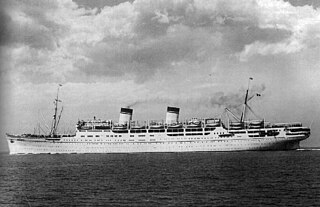
SS Conte Grande was a Lloyd Sabaudo ocean liner built in 1927 by Stabilimento Tecnico Triestino in Trieste, Italy, to service the transatlantic passenger line between Genoa, Italy, and New York City. Launched on 29 June 1927, her maiden voyage was from Genoa to Naples to New York City, which occurred on 13 April 1928. In 1932, after acquisition by the Italian Line, she was transferred to the South America service but was laid up in Santos, Brazil in 1940.

SS Conte Biancamano was an Italian ocean liner launched in 1925. The name was chosen in honor of Humbert I Biancamano, founder of the Savoy dynasty. She was built in the Scottish shipyard William Beardmore & Co. in Dalmuir, near Glasgow. She was built for the Genovese shipping company Lloyd Sabaudo, operator of Conte Rosso and Conte Verde. The engine, equipped with two steam turbines double reduction unit and two propellers, allowed her to reach a speed of 20 knots, and vented in two funnels. She housed 180 passengers in first class, 220 in second class, 390 in economic class and 2,660 in third class.
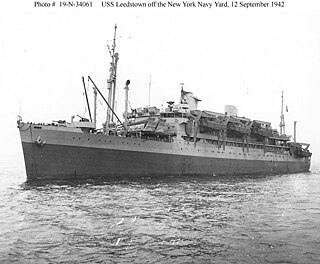
USS Leedstown (AP-73), built as the Grace Line passenger and cargo ocean liner SS Santa Lucia, served as a United States Navy amphibious assault ship in World War II. The ship had first been turned over to the War Shipping Administration (WSA) and operated by Grace Line as the WSA agent from February to August 1942 in the Pacific. In August the ship, at New York, was turned over to the Navy under sub-bareboat charter from WSA. She was sunk 9 November 1942 off the Algerian coast by a German submarine after German bombers caused damage the day before.
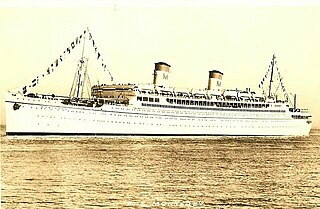
SS Monterey was a luxury ocean liner launched on 10 October 1931. The ship was completed April 1932 and is shown in registers as a 1932 ship. Monterey was the third of the four ships of the Matson Lines "White Fleet", which were designed by William Francis Gibbs and also included SS Malolo, SS Mariposa and SS Lurline. Monterey was identical to Mariposa and very similar to Lurline. During World War II Monterey was used as a troopship operated by Matson as agents of the War Shipping Administration (WSA). Monterey was a large, fast transport capable of sailing independently and was allocated to serving Army troop transport requirements. The ship was involved in an attack on a convoy near Cape Bougaroun.

SS California was the World's first major ocean liner built with turbo-electric propulsion. When launched in 1927 she was also the largest merchant ship yet built in the US, although she was a modest size compared with the biggest European liners of her era.

Built in 1918, the SS Santa Teresa was originally a passenger liner. In World War I she was requisitioned by the U.S. Navy and served under the title USS Santa Teresa. She served as a commercial vessel between the wars, first under her original name, and later as the SS Kent. During World War II she served first with the U.S. Army as the USAT Ernest Hinds, named for Major General Ernest Hinds. She was later part of the Navy as USS Kent (AP-28). She spent the final part of the war as an Army hospital ship, once more under the name USAT Ernest Hinds.

USS George F. Elliott (AP-105) was a cargo liner built for the Mississippi Shipping Company as SS Delbrasil for operation between New Orleans and the east coast of South America in 1939 by its operator, Delta Line. The ship entered that service and operated until taken over by the War Shipping Administration (WSA) on 28 April 1942 for operation by Delta Line acting as WSA's agent. On 25 August 1943 WSA allocated the ship to the Navy for conversion to a troop transport commissioned and operated by the Navy for the duration of the war. Ownership of the ship was transferred from Mississippi Shipping to WSA on 4 February 1944 while under Navy operation and was retained until sale to American South African Lines on 22 December 1948. The ship was renamed African Endeavor until returned as a trade in to the Maritime Commission on 22 September 1960 for layup in the James River reserve fleet and later sold to Boston Metals for scrapping.

SS Santa Rosa was a passenger/cargo ocean liner in service for the Grace Line and later the American-Hawaiian Steamship Company. The vessel also saw military transport service during both World War I and World War II.
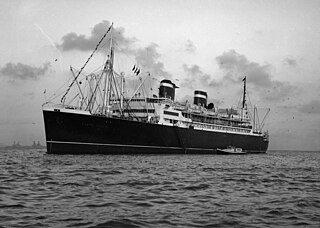
SS Santa Paula was a passenger and cargo ocean liner built for the Grace Line. She was the second of four sister ships ordered in 1930 from the Federal Shipbuilding and Drydock Company of Kearny, NJ. Her regular service route included inter-coastal service between the east coast and the west coast of the US via the Caribbean and the Panama Canal. She later sailed on cruises from New York to the Caribbean and South America. She was the second of three vessels to bear the name Santa Paula for Grace Line service.

SS Brazil was a US turbo-electric ocean liner. She was completed in 1928 as Virginia, and refitted and renamed Brazil in 1938. From 1942 to 1946 she was the War Shipping Administration operated troopship Brazil. She was laid up in 1958 and scrapped in 1964.
Dorothy “Dot” Marckwald (1898–1986) was a prominent American interior designer in the mid-20th century who focused primarily on the interiors of luxury ocean liners. Her most important works were the interiors for the SS America and the SS United States, which was the fastest passenger liner of all time. She worked closely with William Francis Gibbs, one of America’s most renowned naval architects, and her own firm Smyth, Urquhart, & Marckwald, the only firm run by women to decorate the interior of such ships. The interiors of the SS United States were especially innovative because of the use of entirely flame-retardant materials. In total, Marckwald completed the interiors of thirty-one ships, and revolutionized luxury ocean liner design along the way.

USS Santa Olivia (SP-3125) was a cargo ship and later troop transport that served with the United States Navy during and after World War I. The ship later went into merchant service as a freighter, and during World War II took part in a number of transatlantic convoys.
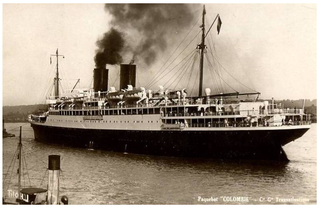
SS Colombie was a French merchant ship and later converted to a hospital ship. She was named after Colombie.

SS India Victory was a Victory ship built and operated as a cargo carrier and troopship in World War II. After the war the ship was used a private cargo ship. She sank on 12 July 1972, ran aground on a Pratas Reef in the South China in Typhoon Susan.
